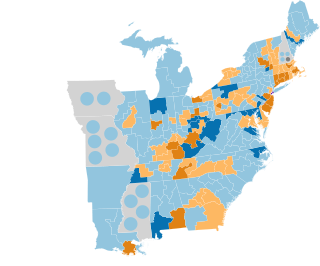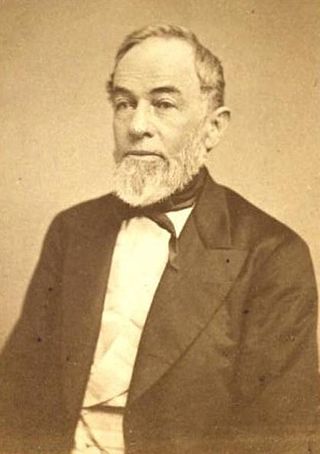
The 29th United States Congress was a meeting of the legislative branch of the United States federal government, consisting of the United States Senate and the United States House of Representatives. It met in Washington, D.C. from March 4, 1845, to March 4, 1847, during the first two years of James Polk's presidency. The apportionment of seats in the House of Representatives was based on the 1840 United States census. Both chambers had a Democratic majority.

The 28th United States Congress was a meeting of the legislative branch of the United States federal government, consisting of the United States Senate and the United States House of Representatives. It met in Washington, D.C., from March 4, 1843, to March 4, 1845, during the third and fourth years of John Tyler's presidency. The apportionment of seats in this House of Representatives was based on the 1840 United States census. The Senate had a Whig majority, and the House had a Democratic majority.

The Territory of Wisconsin was an organized and incorporated territory of the United States that existed from July 3, 1836, until May 29, 1848, when an eastern portion of the territory was admitted to the Union as the State of Wisconsin. Belmont was initially chosen as the capital of the territory. In 1837, the territorial legislature met in Burlington, just north of the Skunk River on the Mississippi, which became part of the Iowa Territory in 1838. In that year, 1838, the territorial capital of Wisconsin was moved to Madison.

The 1844–45 United States House of Representatives elections were held on various dates in various states between July 1, 1844, and November 4, 1845. Each state set its own date for its elections to the House of Representatives. 224 elected members representing 27 states took their seats when the first session of the 29th United States Congress convened on December 1, 1845. The new state of Florida elected its first representative during this election cycle, while one vacancy in New Hampshire's delegation remained unfilled for the duration of the 29th Congress.
George G. King was a farmer from Shields, Wisconsin, who served a single one-year term as a member of the Wisconsin State Assembly from Dodge County for the 1849 session. He was a Democrat.

The Provisional Legislature of Oregon was the single-chamber legislative body of the Provisional Government of Oregon. It served the Oregon Country of the Pacific Northwest of North America from 1843 until early 1849 at a time when no country had sovereignty over the region. This democratically elected legislature became the Oregon Territorial Legislature when the territorial authorities arrived after the creation of the Oregon Territory by the United States in 1848. The body was first termed the Legislative Committee and later renamed the House of Representatives. Over the course of its six-year history the legislature passed laws, including taxation and liquor regulation, and created an army to deal with conflicts with Native Americans.

Oregon's Territorial Legislature was a bicameral legislative body created by the United States Congress in 1848 as the legislative branch of the government of the Oregon Territory. The upper chamber Council and lower chamber House of Representatives first met in July 1849; they served as the region's legislative body until Oregon became a state in February 1859, when they were replaced by the bicameral Oregon State Legislature.

John Catlin was an American lawyer, politician, railroad executive, and Wisconsin pioneer. He was the last secretary of the Wisconsin Territory and briefly served as acting governor of the territory after the creation of the state of Wisconsin but before the Minnesota Territory was formally organized from the remnant, between June 23, 1848, and March 3, 1849. He was also a founding member of the Wisconsin Historical Society. Earlier in his career, he was the first district attorney for Dane County, Wisconsin, and served in the legislature of the Wisconsin Territory during the 4th Wisconsin Territorial Assembly.

The 1844–45 United States Senate elections were held on various dates in various states, coinciding with James K. Polk's election. As these U.S. Senate elections were prior to the ratification of the Seventeenth Amendment in 1913, senators were chosen by state legislatures. Senators were elected over a wide range of time throughout 1844 and 1845, and a seat may have been filled months late or remained vacant due to legislative deadlock. In these elections, terms were up for the senators in Class 1.

The 68th New York State Legislature, consisting of the New York State Senate and the New York State Assembly, met from January 7 to May 14, 1845, during the first year of Silas Wright's governorship, in Albany.
William Fowler was a Native American politician and the first legislator in Wisconsin of known non-European descent. He served in the 1845 session of the Legislative Assembly of the Wisconsin Territory, representing Calumet County and other northeastern counties, and was later treasurer of Calumet County. During the American Civil War, he volunteered for service in the Union Army and died of wounds he received at the Battle of Perryville in 1862.
The Minnesota Territorial Legislature was a bicameral legislative body created by the United States Congress in 1849 as the legislative branch of the government of the Territory of Minnesota. The upper chamber, the Council, and the lower chamber, the House of Representatives, first convened on September 3, 1849. The two chambers served as the territory's legislative body until Minnesota was admitted as a state on May 11, 1858, when the Territorial Legislature was replaced by the Minnesota Legislature.

In the 1843 Iowa Territory Council elections, electors selected councilors to serve in the sixth Iowa Territory Council. All 13 members of the Territory Council were elected. Councilors served one-year terms.

In the 1844 Iowa Territory Council elections, electors selected councilors to serve in the seventh Iowa Territory Council. All 13 members of the Territory Council were elected. Councilors served one-year terms.
Patrick Toland (1801–1858) was a farmer from Erin, Wisconsin who served a single one-year term as a Democratic member of the Wisconsin State Assembly from Washington County and held other public offices.
The First Legislative Assembly of the Wisconsin Territory convened from October 25, 1836, to December 9, 1836, and from November 6, 1837, to January 20, 1838, in regular session. The Assembly also convened in special session from June 11, 1838, to June 25, 1838.
The Second Legislative Assembly of the Wisconsin Territory convened from November 26, 1838, to December 22, 1838, from January 21, 1839, to March 11, 1839, and from December 2, 1839, to January 13, 1840, in regular session. The Assembly also convened in an extra session from August 3, 1840, to August 14, 1840.
The Third Legislative Assembly of the Wisconsin Territory convened from December 7, 1840, to February 19, 1841, and from December 6, 1841, to February 19, 1842, in regular session.

The Fifth Legislative Assembly of the Wisconsin Territory convened from January 4, 1847, to February 11, 1847, and from February 7, 1848, to March 13, 1848, in regular session. The Assembly also convened in special session from October 18, 1847, to October 27, 1847, to organize a second constitutional convention after the failure to adopt the first Wisconsin Constitution.
William Shew was a farmer and businessman from Oak Creek, Wisconsin and Cordova, Illinois who served multiple terms in the Wisconsin Territory House of Representatives representing Milwaukee County, and was Speaker of the House of that body during the first (1847) session of the 5th Wisconsin Territorial Assembly, as well as holding various local government posts.










